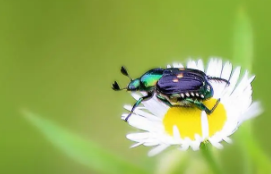- 阅读
- 阅读
- 技巧
- 百科
- 试题
- 文化
- 技能
A butterfly's wings can have many jobs besides keeping the insect aloft.
蝴蝶翅膀除了保持昆虫在空中飞行外,还有许多其他的功能。
They may be called on to attract mates, to warn potential predators to stay away,
它们可能被用来吸引配偶,警告潜在的捕食者远离,
to mimic other animals or even to provide camouflage.
模仿其他动物,甚至提供伪装。

Butterflies engaged in all of these heat-minimising activities even when the researchers blindfolded them.
即使研究人员蒙住它们的眼睛,蝴蝶也会进行所有这些减少热量的活动。
That suggested the relevant sensors were on the wings themselves.
这表明相关传感器是在翅膀上。
Dr Yu and Dr Pierce therefore searched those wings for likely looking sensory cells.
因此虞博士和Pierce博士在这些翅膀中寻找可能的感觉细胞。
They found some, in the form of neurons that resembled heat detectors known from other insects.
他们发现了一些神经元,类似于其他昆虫的热探测器。
They also uncovered disc-shaped cells that appeared, again by resemblance, to be pressure-sensitive neurons.
他们还发现了圆盘状的细胞,它们看起来也像压力敏感的神经元。
They speculate that these are there to detect deformation of the wing—information an insect could use to control its flight pattern.
他们推测这些是用来检测翅膀的变形——昆虫可以利用这些信息来控制飞行模式。
The third discovery Dr Yu and Dr Pierce made to contradict the "dead wing" hypothesis
虞博士和Pierce博士用于反驳“死翅膀”假说的第三个发现
was that some butterfly wings have a heartbeat. Anyone who has looked closely at a butterfly will know that its wings have veins.
是有些蝴蝶的翅膀有心跳。凡是仔细观察过蝴蝶的人都知道它的翅膀上有血管。
These carry a bloodlike fluid called haemolymph.
这些翅膀上携带一种叫做血淋巴的血液状液体。
For a long time, entomologists thought the only role of the veins was, by being pumped full of haemolymph,
在很长一段时间里,昆虫学家认为,血管的唯一作用是在蝴蝶破茧而出后,
to inflate the wings to full stretch after a butterfly emerged from its chrysalis.
通过向翅膀充入大量的血淋巴,使翅膀充分伸展。
More recently, it was discovered that haemolymph continues to flow through the veins throughout the insect's life.
最近发现在昆虫的一生中,血淋巴一直在血管中流动。
Dr Yu and Dr Pierce have now found that in male hairstreaks the haemolymph shows a pulse of several dozen beats per minute.
虞博士和Pierce博士发现在雄性毛发中,血淋巴每分钟搏动几十次。
The source of this pulse appears to be the scent pad, a dark spot on the wings that produces the female-attracting pheromones.
这种跳动的来源似乎是气味垫,即翅膀上产生吸引磁性信息素的黑点。
Apparently, this "wing heart" acts as a pump that helps propel haemolymph through the scent pad.
显然,这个“翅膀心脏”就像一个泵,帮助推动血液淋巴通过气味垫。
In all their experiments simulating different environmental conditions,
在所有模拟不同环境条件的实验中,
Dr Yu and Dr Pierce consistently found that, regardless of pigmentation, the living areas of a butterfly's wings—
虞博士和Pierce博士都发现,不论色素沉着与否,蝴蝶翅膀的活性区域—
which cluster around the veins and are presumably nurtured by them—were always cooler, by up to 10-15°C,
它们围绕在血管周围,可能是由血管滋养的——总是比它们之间没有生命的薄膜
than the lifeless membranes between the veins.
温度低10到15摄氏度。
The cause, they discovered, was that different parts of the wing are covered by different sorts of scales.
他们发现,原因是翅膀的不同部位覆盖着不同种类的鳞屑。
In particular, scales over the scent pads are penetrated by tubes.
尤其是气味垫上的鳞屑被菌管穿透。
This improves their ability to radiate heat away and helps keep the living parts of a butterfly's wing alive.
这提高了它们散热的能力,并有助于保持蝴蝶翅膀的活性部分。
来源:经济学人
参与评论